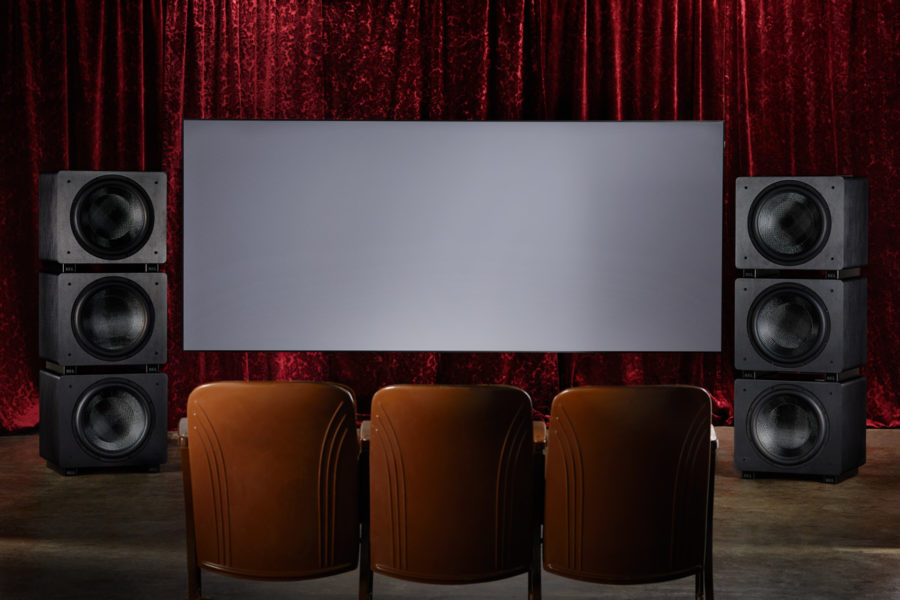Blog
Born for the Silver Screen
Why HT is the Perfect Partner For Movie Night

Among the many conversations we enter into with our customers every day at REL are questions about our newest line, Serie HT, designed to bring out the best for pure theatre applications (though they work far better than most similarly priced subwoofers in music applications too). What makes these new HT’s so special for theatre and how do these differ from classic REL designs?
Understand, these are the first pure theatre designs from REL in the modern era and we took this design brief very seriously indeed. To get theatre right, we removed every built-in preconception about theatre bass and focused like a laser on delivering what the theatre experience should be about. Here’s the key, much of theatre sound-especially the special effects, are made up. They don’t exist, other than in in someone’s imagination.
These special effects are the creation of sound designers being tasked with supplying what a director imagines a future civilization’s weapons might sound like, what a mythical creature’s super power might shade to were he/she/it employing those powers against a titanium chariot being pulled across the sky by mythical beasts of burden. In short, it’s all fantasy but wonderful stuff indeed, made up or not.
While the big special effects are a theatre subwoofer’s stock-in-trade, it’s the rich, everyday warmth supplied by a great theatre subwoofer that makes it able to engage an audience for the entirety of a 2-hour film, action or a smaller, more intimate film. It is these smaller scale sounds that are the difference between great theater subwoofers and bombastic-but-annoying boom makers. Let’s dive in to see what we mean.
The BIG, the BAD and the Ugly

Large scale effects reproduction requires not just extremely high output levels (the BIG) but extremely reactive qualities to the bass. Most subwoofers will play loud in theatre applications, but without instantaneous speed it lumbers along (the BAD). Some are incapable of starting and stopping in tempo with the action occurring on screen, not understanding the difference between loud and loutish (the Ugly). The product of sloppy driver suspensions, soft under damped surrounds they are the buffoons of the subwoofer world.
If a subwoofer is merely loud, but lacks the ability to start and stop instantaneously, then the unspoken trust between filmmaker and audience is violated. For movie sound to verge on epic, bass must be ridiculously fast; must be able to lash out, knock one off ones’ feet, snap ones’ head back in reaction to action visited on screen. Loud is good, very loud with wicked fast deep bass and the ability to deliver a concussive blow trumps all. We–REL–crave bass that shocks, violates, sends one scrambling. So very loud, very fast and textural is the winning combination.
To that end, we shave mass from the moving parts of our drivers—the cone, spider and surrounds. Our cones are carefully laid up from lightweight glass fibre stiffened by carbon fibre centerpieces. In turn, this allows us to use crisper, more agile materials in our suspension components—the stuff that actually supports and controls the fore-and-aft movement of the cone. Much like an automobile’s suspension and brakes, these allow our drivers to start and stop on a dime.
Now, let’s return to the everyday sounds that are so important for movies to become believable. The use of Foley effects and additional sounds being layered into the softer scenes in movies are what makes the occasional special effect have so darned much impact. This is where our theatre filters work their magic. Our input filters use slightly sharper curves than our classic series. This has the effect of speeding up the perceived speed and slam. While specially derived curves extend out the lowest bass notes so critical to delivering the body blows of BIG theatre.
Without a soft dialogue-laden scene to lull one into a false sense of security, the head of the dragon suddenly rearing up with a mighty roar lacks the startling quality necessary to sell the moment. Here too, REL’s organic wholeness of design priorities means that intimacy is captured, that scale and size of settings is accurately portrayed sonically, such that the viewer sinks into a scene, taking a moment to relax, hearing rich timbres they are used to in real life. Trusting. Only to be startled out of it as the merry-go-‘round of action on film explodes into the next effects-based scene.
The purpose of specific theatre-designed RELs means that large scale special effects takes on spectacular meaning. Yet, for the many moments of normalcy that exist in even the most prodigious of Hollywood action thrillers, many more minutes of comparative normalcy is required to both provide context and to offer the audience refuge from the tumult and bombast of the special effects to follow.
The next time you sit down to listen to an HT, think about the sound, both large-scale and loud set against the reference point of small-scale and intimate needed to form the whole of a movie and remember that our engineers work to bring you the entire movie—not merely the 18 minutes of bombast and explosions that sells the ticket.
Pro Tip:
For the most natural setup, set the HT’s crossover to 9 o’clock or below. Doing so ensures the most accurate, natural voicing and also permits it to be turned up to the preternaturally loud outputs of which HT’s are capable.










